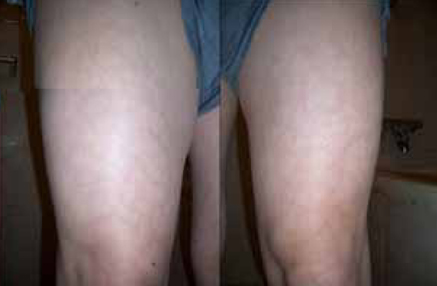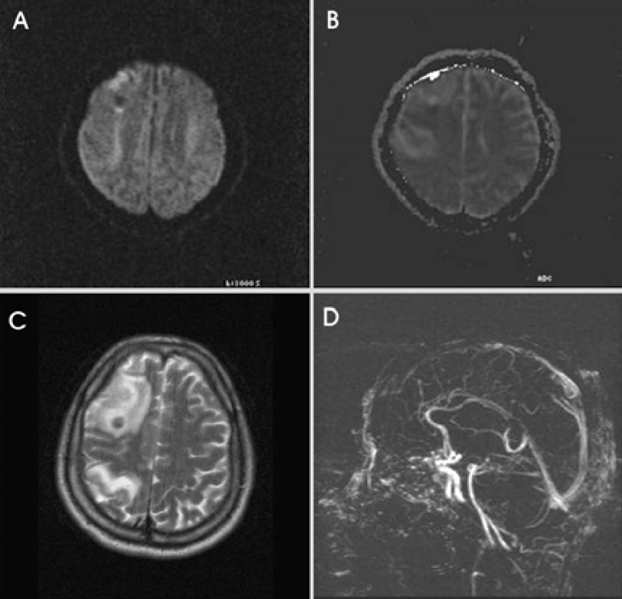J Clin Neurol.
2006 Jun;2(2):137-140. 10.3988/jcn.2006.2.2.137.
Cerebral Venous Thrombosis and Livedo Reticularis in a Case with MTHFR 677TT Homozygote
- Affiliations
-
- 1Department of Neurology, College of Medicine, Seoul National University, Seoul, Korea. kimmanho@snu.ac.kr
- KMID: 1700747
- DOI: http://doi.org/10.3988/jcn.2006.2.2.137
Abstract
- Hyperhomocysteinemia associated with methylene terahydrofolate reductase (MTHFR) mutation can be a risk factor for idiopathic cerebral venous thrombosis. We describe the first case of MTHFR 677TT homozygote with cerebral venous thrombosis and livedo reticularis. A 45-year-old man presented with seizures and mottled-like skin lesions, that were aggravated by cold temperature. Hemorrhagic infarct in the right frontoparietal area with superior sagittal sinus thrombosis was observed. He had hyperhomocysteinemia, low plasma folate level, and MTHFR 677TT homozygote genotype, which might be associated with livedo reticularis and increase the risk for cerebral venous thrombosis.
MeSH Terms
-
Cold Temperature
Folic Acid
Genotype
Homozygote*
Humans
Hyperhomocysteinemia
Livedo Reticularis*
Methylenetetrahydrofolate Reductase (NADPH2)
Middle Aged
Oxidoreductases
Plasma
Risk Factors
Seizures
Skin
Superior Sagittal Sinus
Thrombosis
Venous Thrombosis*
Folic Acid
Methylenetetrahydrofolate Reductase (NADPH2)
Oxidoreductases
Figure
Reference
-
1. Homocysteine Studies Collaboration. Homocysteine and risk of ischemic heart disease and stroke. A meta-analysis. JAMA. 2002. 288:2015–2022.2. den Heijer M, Koster T, Blom HJ, Bos GM, Briet E, Reitsma PH, et al. Hyperhomocysteinemia as a risk factor for deep vein thrombosis. NEJM. 1996. 334:759–762.3. Martinelli I, Battagliolo T, Pedotti P, Cattaneo M, Mannucci PM. Hyperhomocysteinemia in cerebral venous thrombosis. Blood. 2003. 102:1363–1366.4. Cantu C, Alsonso E, Jara A, Martinez L, Rios C, Fernandez Mde L, et al. Hyperhomocsyteinemia, low folate and vitamin B12 concentrations, and methylene tetrahydrofolate reductase mutation in cerebral venous thrombosis. Stroke. 2004. 35:1790–1794.
Article5. Blom HJ. Mutated 5,10-methylenetetrahydrofolate reductase and moderatehyperhomocysteinemia. Eur J Pediatr. 1998. 157:S131–S134.6. Kasper DL, Braunwald E, Fauci AS, Hauser SL, Longo DL, Jameson JL. Harrison's Principles of Internal Medicine. 2005. 16th ed. United States of America: The McGraw-Hill Companies, Inc;1460–1461.7. Lee DH, Park CI, Lee IH, Lee JM, Kim SH, Lee JY, et al. An adolescent ischemic stroke patient with hyperhomocysteinemia, MTHFR 677T and CBS 1080TT genotypes. J Korean Neurol Assoc. 2005. 23:382–385.8. Koo JS, Yoon BW, Kim J. A patient with homocystinuria complicated by superior sagittal sinus thrombosis: a case report. J Korean Neurol Assoc. 1997. 15:1271–1279.9. Kim SJ, Heo K, Ye JS, Lim SR, Kim OK, Cho HK. A case of deep cerebral venous thrombosis associated with hereditary protein C deficiency. J Korean Neurol Assoc. 1996. 14:567–571.10. Kim JC, Kang SY, Song HS, Lee SA. Cerebral venous sinus thrombosis associated with antithrombin III deficiency: a case report. J Korean Neurol Assoc. 2000. 18:637–641.11. Lee MS, In SW, Lee SJ. A case of cerebral venous thrombosis in paroxysmal nocturnal hemoglobinuria. J Korean Neurol Assoc. 1986. 4:246–250.12. Ventrura P, Covelli M, Marietta M, Panini R, Rosa MC, Salvioli G. Hyperhomocy-steinemia and other newly recognized inherited coagulation disorders (Factor V Leiden and prothrombin gene mutation) in patients with idiopathic cerebral vein thrombosis. Cerebrovasc Dis. 2004. 17:153–159.
Article13. Cattaneo M. Hyperhomocysteinemia, atherosclerosis and thrombosis. Thromb Haemost. 1999. 81:165–176.
Article14. Harpel PC, Zhang X, Borth W. Homocysteine and hemostasis: Pathogenic mechanisms predisposing to thrombosis. J Nutr. 1996. 126:1285S–1289S.15. Finkelstein JD. The metabolism of homocysteine: pathways and regulation. Eur J pediatr. 1998. 157:S40–S44.
Article



